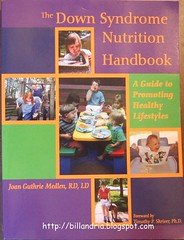Hypotonia or low tone is common for individuals with Down syndrome. It affects their overall development from walking later to eating. With low oral-motor tone, a more intense oral sensory input is required to "wake-up" the muscles in and around the mouth in order for oral motor skills to develop. Matthew's Occupational Therapist (OT) had several suggestions for helping him transition including oral alerting activities, offering Matthew high flavor food, thickening food to increase texture, and practicing chewing.
Oral Alerting Activities

 Oral alerting is done to help increase sensory awareness of the face and mouth muscles before a meal, in effect, encouraging more coordinated use of the mouth (jaw, lips, cheeks, and tongue) and developing a more efficient biting, chewing, and swallowing pattern. Some oral alerting techniques are: a cool-cold washcloth wake-up, finger tapping on the face, and vibration using a NUK brush, z-vibe, or jiggler. I'm sure any OT would be more than willing to discuss these in more detail. We have the z-vibe and elephant jiggler pictured here.
Oral alerting is done to help increase sensory awareness of the face and mouth muscles before a meal, in effect, encouraging more coordinated use of the mouth (jaw, lips, cheeks, and tongue) and developing a more efficient biting, chewing, and swallowing pattern. Some oral alerting techniques are: a cool-cold washcloth wake-up, finger tapping on the face, and vibration using a NUK brush, z-vibe, or jiggler. I'm sure any OT would be more than willing to discuss these in more detail. We have the z-vibe and elephant jiggler pictured here.Offering High Flavor Food
Did you know that hypotonia affects taste too? Sara Rosenfeld Johnson, a renowned speech and language pathologist (SLP), affirms this in Low Tone Affects Taste as well as Movement on her blog Sara's Feeding and Speech Thoughts. Here's an excerpt:
"...when children are diagnosed with Low Tone/Hypotonicity it also means they may have Hypo-sensitivity/Hypo-responsivity to touch, taste and smell. He likes foods that are highly flavored because he can "taste" them. Kids with hypo-sensitivity like foods they can taste so increasing flavor for these kids is essential."Matthew does like the tartness of blueberry pomegranate flavored applesauce (Musselman brand). But on the other hand, he also likes bland jarred baby food. Go figure!
Thickening Food
To this day, Matthew eats jarred 2nd (baby) food. Occasionally, he'll eat home-made pureed food mixed with jarred baby food. He also eats jarred 3rd foods - pears and squash only - which do not have the chunks of food like the other 3rd foods do but they have a thicker consistency than 2nd foods. Sometimes I thicken the 2nd foods with rice or oatmeal cereal to add texture. The thicker texture encourages learning to coordinate the tongue and jaw movements to handle the food differently than if it were runny, therefore helping improve oral motor skills.
Practicing Chewing
A teething feeder filled with fruit is great for Matthew to practice chewing and biting solid food without the risk of choking. His OT says that not all kids like this feeder, probably because of the texture of the feeder in their mouths. Matthew didn't care for it initally but he warmed up to it after several attempts of offering it to him. He also eats cheerios, goldfish crackers, small chunks of fresh pear, nutrigrain blueberry toaster waffles, and cinnamon graham crackers. I try to offer one of these after every other meal so he can practice chewing often.
Food Progression
In the last four or five months, I have been trying to step-up my efforts in transitioning Matthew from baby food to table (non-pureed) food. I fed him small pieces of Gerber pasta pick-ups, which caused him to gag and throw up. I fed him 3rd foods Lasagna, which also caused him to gag and throw up. I fed him buttered steamed carrots. He cried a little, tolerated a few pieces then he was done. I tried feeding him some green beans from a Gerber Graduates - Lil' Entrees for Toddlers meal but after getting one piece in his mouth, he cried and refused more.
I recently stumbled upon "Food Progressions for Biting and Chewing" by Suzanne Evans Morris, Ph.D, who is a Speech-Language Pathologist and author of a few books on pre-feeding skills and pre-speech. She identifies 8 sensory features of food (sensory input, size, shape, texture scatter, consistency, placement, and need for transfer during chewing) that help determine the degree of ease or difficulty for biting and chewing, how these require different sensorimotor strategies, and that a high level of success is important.
 After reading Suzanne Evans Morris' work, I had an epiphany. MAYBE I sabotaged my own efforts to transition him from baby food to non-pureed food by giving him food that he was not developmentally ready for, triggering his sensitive gag reflex and causing him to gag and throw-up. Because of these unpleasant experiences, I might have created a certain level of fear and distrust of new table food, thereby making the transition more difficult. So it seems I need to re-evaluate my transition efforts and understand the different sensory features that each food presents in order to offer more appropriate choices that match his current level of oral-motor skills. I need to take a closer look at the chart of guidelines for matching oral motor skills with food textures in "Chapter 7: Successful Eating" of The Down Syndrome Nutrition Handbook by Joan Guthrie Medlen, RD, LD.
After reading Suzanne Evans Morris' work, I had an epiphany. MAYBE I sabotaged my own efforts to transition him from baby food to non-pureed food by giving him food that he was not developmentally ready for, triggering his sensitive gag reflex and causing him to gag and throw-up. Because of these unpleasant experiences, I might have created a certain level of fear and distrust of new table food, thereby making the transition more difficult. So it seems I need to re-evaluate my transition efforts and understand the different sensory features that each food presents in order to offer more appropriate choices that match his current level of oral-motor skills. I need to take a closer look at the chart of guidelines for matching oral motor skills with food textures in "Chapter 7: Successful Eating" of The Down Syndrome Nutrition Handbook by Joan Guthrie Medlen, RD, LD.Despite these few bumps on the road, I'd like to think we are headed in the right direction and employing the right strategies to help him overcome his minor feeding difficulties. Over time, with frequent exposure to different foods and practice chewing, I hope he will eat a wide variety of table food when he's older... unless his Daddy's picky-eater gene has the last say.








12 comments:
Thanks for the book recommendation! We start solids tomorrow so this post was very timely!
darn it, just wrote a long comment and it didn't go through. :( anywho, great post...had no idea about the hypersensitivety. i'll have to pass that along. and hang in there about feeding. it took henry awhile to catch on, but once i knew he could handle the chunkier foods i quit baby food cold turkey with him. he definitely protested for a bit but he finally got used to table foods. it's hard work for them to eat table foods. it takes more energy, more time, more effort...they don't like it. but he'll get there!
Maybe Matthew just thinks Gerber 3rd foods are yucky...lol. I think I would gag and throw up too if I had to eat them :-) I think some foodie issues are because we wait too long to introduce new stuff and our little ones are already in the habit of eating a certain way.
I have read/heard a lot about the high flavor thing but I wonder when it becomes a real benefit because for now my daughter's favorite food is a Happy Baby Puff, which tastes like cardboard to me.
This is a great post.
I found the info on taste to be very interesting. Maybe that explains why John Michael loves my somewhat spicy turkey white bean chili and my mother-in-law's Bahmi Goreng. The more flavor, the better. Spaghetti, yes, green beans, no. He also like tomato and roasted red pepper soup with extra garlic and basil in it. He spits out vegies, so I try to sneak them in. As for Matthew's applesauce, I think pomegranate has a soury taste, so maybe it's just the taste and not the texture for him. Thanks for the post.
Ria,thank you for your informative posts. Our Little J is 11 months old, so I enjoy reading up on what's to come in the near future. I, too, am reading the Down Syndrome Nutrition Handbook. Chapter 7 sounds like one to read. I've read through the first 4 or 5 chapters and haven't found anything incredibly useful yet. But I guess I should keep reading. I watched one of your videos for the first time and Oh My Gosh have I been missing out. I need to watch them all. Maybe in my spare time.
Hi Ria! I am Artie's mom from Doin' it down to earth. Awesome research! Thanks for pulling it all together.
I knew knew knew that he liked strong foods for a reason.
Good stuff!
Ann
very good post. thanks again for the book recommendation. I'm currently reading The New language of Toys, based on your suggestion/review.
Meredith, Happy Transitioning!
Heidi, oh darn indeed! It aggravates me when that happens. I've been trying to make it a habit of copying any long comments to the clipboard before trying to send. Thanks for the encouragement!
Thanks Sandra/ dsmama. I agree! 3rd foods is just...eewww. It seems though that the biggest pet peeve for most therapists is that the manufacturers mix textures (a puree with chunks), which is a confusing sensory experience for some kids who are still learning to transition. Pears and Squash 3rd foods though, has just one consistent texture - no chunks. Also, high flavor may also be a matter of preference and food exposure. But hearing from many moms who have kids with DS, high flavor sure seems like the norm. Matthew is a cheerio monster. He'll eat cheerios all day if you let him. Cheerios aren't exactly "high flavor" but I think he likes the easy crunch factor it offers.
Monica, wow! John Michael has a very appreciative palate (and appetite!). Matthew should take notes from him. I might try some of the things you feed him, but maybe just grind it up. I have tried giving Matthew spaghetti sauce and he liked that - no noodles though, just the sauce. And do you mean bahmi goreng - the Indonesian dish? I miss dishes like that. mmmm...
Jen, yup Chapter 7 is helpful to me right now. I like the chart on page 83...or was it page 84? One of those pages has a chart that matches oral motor skills to food texture. But I don't think it says anything about taste so that might be something you may want to explore too for Little J.
Ann, thanks for stopping by and commenting. I think I have your blog in my Reader now.
And thank you, Patti!
Oh I am so excited that all this information is getting out to the younger set!! It was so difficult to find this kind of stuff 9 or 10 years ago! So glad you are sharing what you've found!
Great post!Lots of good information!
Very interesting! Praise the Lord that Anna is a good eater - she eats more than my 3-yr. old! But, I know many kids with food/eating issues -- hang in there! Oh-- and none of my kids liked the stage 3 foods. We moved straight from stage 2 to finely chopped/ground table foods, like chicken, beans, fresh fruit, etc.
I found the part about taste particulary interesting. I have given Anna some pretty spicy foods and she barely bats an eye -- maybe that is why.
Thanks for sharing!
Assuming food allergies are not an issue try a taste test. When Maya was 4 months old my husband set up a tray of ingredients...lime juice, mustard, maple syrup, pickles... you name it. He would take a spoon dip it and lightly dab it on her tongue. Between tastes he would give her sips of water. She appeared to like some, hate some but this helped her develop an interest in foods. I basically gave her fresh steamed green beans, carrots, corn and she loved it... hated Gerber graduates and other preprocessed food. Now at 10 she is a connoisseur of fine cuisine. Is able to detect wild vs farmed salmon... tells me how to spice her foods.....
Post a Comment